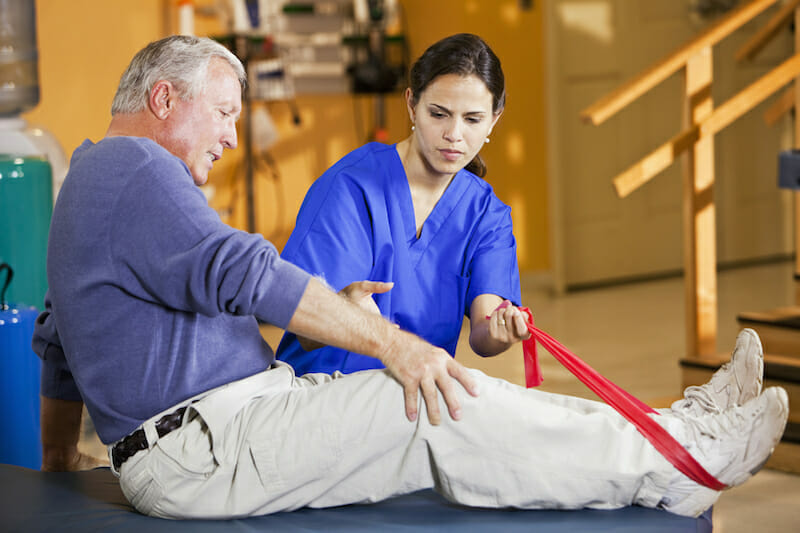Osteoarthritis, also known as degenerative joint disease, affects close to 21 million people in the United States. Osteoarthritis in the knee or hip is the most common cause of arthritis-related disability.
As baby boomers age, orthopedic surgeons are performing more and more total joint replacement surgeries, including total knee replacements and hip replacement surgeries.
Physical therapists are trained to identify limitations of the body, and are knowledgeable about surgical procedures and treatment goals for a post-surgical patient.
Most importantly, physical therapists can tailor their efforts to improve the overall well-being of a patient with a new knee or hip and ensure long-term success.
Foundations of Post-Surgery Physical Therapy
IN THIS ARTICLE

After undergoing surgery, the recovery process can be a lengthy and challenging journey.
Physical therapy can play a crucial role in restoring mobility, strength, and range of motion to the affected area.
The foundation of post-surgery physical therapy is to set realistic goals for recovery and to work with a physical therapist to develop a personalized rehabilitation plan.
Setting Realistic Goals for Recovery
The first step in post-surgery physical therapy is to set realistic goals for recovery.
A physical therapist will work with the patient to identify the areas that need improvement and develop a plan to achieve those goals. It is important to remember that recovery is a gradual process and that progress may be slow at times. However, with consistency and dedication, patients can achieve their goals and regain their independence.
Physical therapy can help in the healing process by restoring muscle strength, joint mobility, and overall function. The therapy is particularly vital following surgeries such as joint replacements or procedures involving soft tissues, where motion exercises and strengthening activities play pivotal roles.
The physical therapist will assess the patient’s range of motion, strength, and flexibility and develop a personalized rehabilitation plan tailored to their needs.
The plan may include exercises to improve strength and flexibility, as well as modalities such as heat or ice therapy to reduce pain and inflammation.
Key Benefits of Post-Surgery Physical Therapy

Let’s explore some of the key benefits of physical therapy after surgery, as well as some of the techniques used by physical therapists to achieve these benefits.
Post-surgical rehabilitation from a physical therapist offers the following long-term benefits:
- Restore normal movement to the joint
- Build up strength in the joint and surrounding muscles
- Ease pain and swelling
- Guide an individual back to normal activities
- Help with circulation, particularly right after surgery, so the patient does not have problems with blood clots
To achieve these long-term goals, physical therapists offer multiple strategies, stretches, and techniques.
Stretches for Muscles and Joints
Stretching is vital in maintaining a good range of motion for joints and the flexibility of muscles. If the individual has stiff joints or tight muscles, normal activities, such as climbing stairs or reaching overhead, can be severely affected.
With proper stretching, these functions can be preserved. After an injury or surgery, scar tissue forms and soft tissue contracts, so stretching is especially important.
Let’s get a little more in-depth into these benefits.
Improving Strength and Mobility
One of the primary goals of physical therapy after surgery is to improve strength and mobility. This is achieved through a combination of exercises and stretches that are designed to target specific muscles and joints.
These exercises may include resistance training, balance exercises, and range of motion exercises.
By improving strength and mobility, patients can regain their independence and perform daily activities with greater ease.
Managing Pain and Swelling
Pain and swelling are common after surgery, but physical therapy can help manage these symptoms.
Manual therapy techniques, such as massage and joint mobilization, can help reduce pain and swelling by improving circulation and reducing inflammation.
Modalities such as ice or heat therapy may also be used to help manage pain and swelling.
Enhancing Quality of Life
Physical therapy after surgery can also enhance a patient’s quality of life. By improving strength, flexibility, and balance, patients can perform activities they may have previously been unable to do.
This can lead to increased confidence and a greater sense of independence. Additionally, physical therapy can help reduce the risk of falls and other accidents, which can further improve a patient’s quality of life.
Exercises to Strengthen the Body
Strengthening exercises help the patient improve the function of the muscles surrounding the replacement.
The goal is to improve strength and increase the range of motion of the replaced joint over time.
Recently, physical therapists have placed more emphasis on core strengthening, because the body’s core is its foundation. Strengthening muscles in the back and pelvis increases stability and improves balance, which goes hand-in-hand with a successful recovery from knee or hip replacement.
Ice and Heat Application
Ice and heat are useful in warming up and cooling off muscles. In addition, these methods can stimulate blood flow and decrease swelling, important parts of the healing process. The key to proper treatment is knowing when to ice and heat an injury.
Ultrasound
Ultrasound uses high-frequency sound waves to stimulate the deep tissues within the body, which leads to warming and increased blood flow to these tissues.
Electrical Stimulation
Electrical stimulation is a therapy that passes an electrical current to an affected area. Nerve conduction within the region is altered, which can in turn alter muscle contractility. Blood flow to these tissues is also increased with electrical stimulation. Patients often experience less pain after electrical stimulation.
Depending on the surgery and the individual, specific treatments will be used. For instance, individuals who undergo knee replacement surgery may need to wear support stockings, apply cold packs, and elevate the leg for up to 3 months after surgery to relieve swelling.
They would engage in range-of-motion exercises specific to the knee, strengthening exercises for the legs, and balance training. For an individual undergoing hip replacement surgery, they may have to do ankle pumps and exercises to contract and release muscles in the legs and buttocks.
A physical therapist will work with a hip surgery patient, alongside an occupational therapist and discharge planner, to ensure a successful post-surgical recovery.
Navigating the Recovery Journey

After undergoing surgery, the journey to recovery can be challenging and overwhelming.
However, with a comprehensive rehabilitation plan in place, patients can recover quickly and regain their independence. In this section, we will explore the importance of developing a comprehensive rehabilitation plan and overcoming common post-surgery challenges.
Developing a Comprehensive Rehabilitation Plan
A rehabilitation program is crucial in the recovery process after surgery.
The plan should be tailored to the patient’s specific needs and goals and should take into account any complications that may arise during the healing process.
The rehabilitation plan should include postoperative physical therapy to restore mobility, reduce pain, and prevent the formation of scar tissue.
The rehabilitation program should also include exercises that target the affected area and help patients regain strength and flexibility.
Overcoming Common Post-Surgery Challenges
Patients may experience various challenges during the recovery process, including pain, swelling, and limited mobility. It is essential to communicate any concerns or complications with the physical therapist to ensure that the rehabilitation plan is adjusted accordingly.
Scar tissue formation can also be a common issue after surgery, which can limit mobility and cause pain. Physical therapy can help break up scar tissue and restore mobility to the affected area.
Get the Post-Surgery Care You Need
Physical therapists are dedicated to helping their patients gain back function, so that the patient can start enjoying life pain-free again.
If you or a loved one has surgery scheduled, ask your doctor about your post-surgical care plan. NurseRegistry can accompany post-surgical care from a physical therapist by providing wound care, medication management, pain management, and more.
Click below to learn more about how we can help you with your post-surgical recovery.
Frequently Asked Questions about Post-Surgery Physical Therapy
How long is physical therapy required after undergoing surgery?
The duration of physical therapy required after surgery varies depending on the type of surgery, the patient’s age, and the extent of the injury or condition. Brain surgery will naturally be different than replacing a hip. In general, physical therapy can last for several weeks to several months. The patient’s progress is closely monitored by the therapist, and the therapy sessions may be adjusted accordingly.
What are the potential consequences of skipping physical therapy post-surgery?
Skipping physical therapy after surgery can have several negative consequences. It can lead to prolonged pain, stiffness, and reduced mobility. It can also result in the formation of scar tissue, which can further limit the range of motion. In some cases, it may even lead to the need for additional surgery.
What specific goals does physical therapy aim to achieve following a surgical procedure?
Physical therapy aims to help patients regain strength, flexibility, and mobility following surgery. It can also help to reduce pain and inflammation. The specific goals of physical therapy will vary depending on the type of surgery and the patient’s individual needs, but may include improving range of motion, increasing strength, and enhancing balance and coordination.
Can physical therapy impact the mental recovery process after surgery?
Yes, physical therapy can have a positive impact on the mental recovery process after surgery. It can help to reduce stress and anxiety, and can also improve mood and overall well-being. Physical therapy can also provide a sense of accomplishment and progress, which can be beneficial for patients who may be struggling with the emotional effects of surgery.
What are the indicators that someone needs to start physical therapy after surgery?
Indicators that someone may need physical therapy after surgery include pain, stiffness, reduced range of motion, and difficulty performing daily activities. If a patient is experiencing any of these symptoms, they should speak with their healthcare provider about the possibility of physical therapy.
How does physical therapy contribute to the overall rehabilitation post-surgery?
Physical therapy is an essential component of the overall rehabilitation process following surgery. It can help patients regain strength, flexibility, and mobility, and can also reduce pain and inflammation. By working closely with a physical therapist, patients can achieve their rehabilitation goals and improve their overall quality of life.
Sources Cluett, J., “How Physical Therapy Can Help Your Recovery,” Verywell.com, July 30, 2016 Hoobchaak, Liz, “Physical Therapy after a Hip Replacement,” Athletico Physical Therapy, January 16, 2013.
“Importance of Exercise for Patients Facing Arthritis and Total Knee Replacement,” Plancher Orthopedics and Sports Medicine, 2017.
“Physical Therapist’s Guide to Total Knee Replacement,” Move Forward, 2017 “Recovering from Hip Replacement Surgery,” UCSF Medical Center, 2017.






